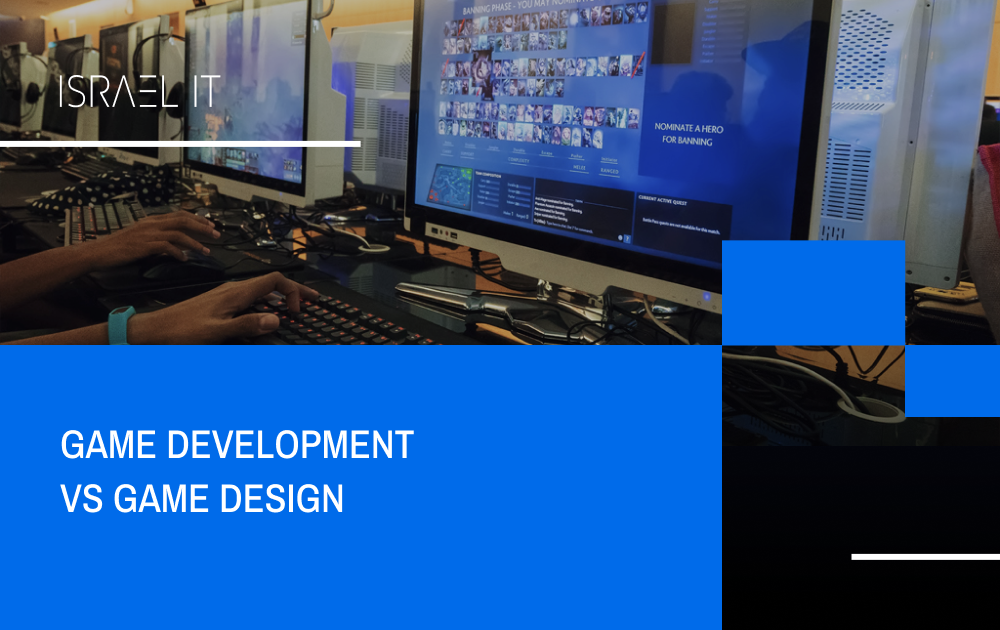With new technological inventions, the demand for games has increased drastically, which increases the demand for high-quality games. Increased complexity of video games and integration of artificial intelligence (AI) and machine learning has brought about the uniqueness in storylines and the codes used in the game development and design.
When contrasting game development vs. game design, you need to consider the creativity and development element of stellar gameplay features and mechanics, and of course you need to gain the knowledge on how to manage the game development team. In as much as design and development appear similar, they are different but interdependent concepts. This article shows you how these fields interconnect in game development processes.
Game Development vs. Game Design
The game design falls under the development of a game. It involves using technology to come up with players, game rules, a story and specific challenges that spike interaction between players, users or objects. On the other hand, game design involves sketching, writing plot scripts, and creating layouts that will make the game stand out. Game developers turn vision into reality.
In essence, game development involves:
- Planning for the game development process from ideation to launch
- Transforming game design iterations into a playable game
- Game testing to spot and fix bugs
- Collaborating with software developers
- Implementing AI and machine learning
- Creating and inspecting the code
The game design process involves:

- Ideation and conception of the game
- Developing the gameplay concept
- Providing themes and genres
- Developing plot points and storylines
- Researching about gaming trends
- Developing characters, their roles and capabilities
- Conceptualization of maps and difficulty levels
There are rules and objects of the game in every game design and interactions between the player, rule and objects. Savvy designers use feedback to bolster their game’s layout and gameplay.
Technical Considerations
Distinguishing the underlying concepts between game development vs. game design means outlining the technical aspects of the game. The development process encompasses bringing to life ideas of the game by using programming languages to code. Design is more of a market-oriented, design-driven or technology-driven approach.
Game development involves creating a game concept, programming, recording, mixing, recording, producing, and testing functionality. It is basically the procedure for creating video games by merging players in a game, the story, audio, art and lighting.
The development process occurs through phases and encompasses:
- Planning: budgeting, deciding on methodology, assigning tasks and developing iterations
- Programming: using codes to actualize design concepts and ideas
- Evaluation: using beta releases to test gameplay and fix known bugs
- Game launch: releasing the first version of the game. Collecting feedback is crucial in this stage
In regard to finance, commercial game development projects are funded by publishers, while independent video games are funded by individuals.
In-game design, the technical considerations to consider include:
- Technological concepts of the game. Ideally, the game should meet the current video game video, audio and gameplay quality standards
- The storyline should be unique, relatable and appealing to the gamers
- Character development and animation process should be exemplary
- Relatable and quality sound effects and visuals
When looking into game development vs. game design technical components, note that a good game provides challenges while at the same time should be a good business application. As such, the development and design concepts should balance with the monetization of the game.
Things to Consider
Building the architecture of the game and actualizing it is a continuous process that goes through various phases. One of the things to consider in the process is audio production. The sounds produced should coincide with the motions and game intensity. Your characters and background voices, including music, should be realistic and create a life-like atmosphere.
Designers focus on art as it gives gamers the feel of the game. It includes 3D presentations, lighting and game textures. Work on converting design ideas to reality by converting the sketch art into the final product to be consumed by your customers.
You can control mood in your video game development by using lighting related to the situation at hand. You can manipulate your light settings to suit events. For horrific scenes, use reduced lighting while bright lights are employed in fun games or adventurous games.
To keep your customers excited, implement the addition of game levels to provide more adventures and difficult tasks; players need to be motivated to keep playing on for more desirable features of the game to be unlocked.
Designers vs. Developers
Good game designers are creative, innovative, excellent communicators and problem solvers, while for programmers, artistic, visual, and codding skills are essential. To highlight the differences between game development vs. game design, you need to highlight the functions of designers and developers.
Game designers keep up with trends, create a plan, acquire knowledge on existing games, create new gaming ideas, develop stories and characters, and provide information on the target audience. Game development crew are programmers, designers, and content creators, while game design encompasses game designers only.
Game developers make the game playable, test game and fix challenges, conduct code inspection for errors, and enable movement in the players through artificial intelligence
If you plan on starting a video game project and looking for software developers to take you through the process, Israel IT is an expert with game developers in the industry. Besides, outsourcing game development services give you the opportunity to benefit from the skills of top designers and developers in the industry. Call or text Israel IT today to get you started on your game development project.




